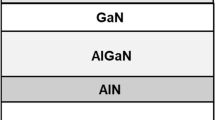Abstract
In this paper, the mechanism of Hg1−xCd x Te/Si heterojunction grown by HWE (Hot Well Epitaxy) was studied. Opitical characterizations were shown with FTIR, the composition x = 0.39 was deduced by using MIR transmittance, the absorbing peak at 319.4 cm−1 was measured by FIR transmittance, 319.4 cm−1 confirmed the existence of Si–Te bond of at Si/HgCdTe interfacial layer. The I-V characteristics at both room temperature and 77 K of HgCdTe (n-type)/Si (p-type) heterojunction show that the good p-n heterojunction properties was obtained by using HWE. XRD study confirmed the formation of (111) oriented HgCdTe on (211) Si. Morphology of a cross section observed using EPMA indicates the columnar growth of HgCdTe. An analysis of interfcial layer by EPMA indicated presence of three layers composed of Si + Te, Si + Te + Hg and Si + Te + Cd + Hg. Among them, the most important one is the first layer. The problem of lattice mismatch and the difference of thermal expansion coefficient between Si and CdTe or HgTe may be improved by formation of Si–Te stable chemical bond through bybridization orbital bonding between Si and Te. The second and third layers are formed by evaporation-interdiffusion. Formation of the whole interfacial layer provides the appetency for the growth of (111) Hg1−xCd x Te epilayer on (211) Si substrate.
Similar content being viewed by others
References
S. BERNARDI, SPIE 2816 (1996) 2.
T. Y. GORBACH, P. S. SMERTENKO, S. V. SVECHNIKOV, M. KUZMA, G. WISZ and K. CIACH, Appl. Surf. Sci. 154/155 (2000) 495.
V. C. FARMER, in “The Infrared Spectra of Minerals” (Mineralogical Society, London, 1974) p.398.
SWARTHMORE, in “Powder Diffraction File. Inorganic and Organic” (JCPDS-International Centre for Diffraction Data, Pennsylvania, 1974) (150770) and (320665).
A. MILLION, N. K. DHAR and J. H. DINAN, J. Crystal. Growth 159 (1996) 76.
R. R. HAO, X. Y. FANG and S. C. NIU, in “ Inorganic Chemistry Series Vol.3, Carbon Silicon Germanium Subgroup” (Science Press, Beijing,1998) p.131.
G. Y. HONG, in “ Inorganic Solid Chemistry” (Science Press, Beijing, 2002) p. 271.
J. P. FAURIE, R. SPORKEN, S. SIVANANTHAN and M. D. LANGE, J.Crystal Growth 111 (1991) 698.
W. T. ZHENG, in “ Thin film materials and thin film technology” (Chemical Industry Press, Beijing, 2004) p. 162.
Author information
Authors and Affiliations
Corresponding author
Rights and permissions
About this article
Cite this article
Yang, A., Tang, L., Wu, C. et al. Studies on growth mechanism of HgCdTe epilayer on Si grown by HWE. J Mater Sci 40, 6453–6458 (2005). https://doi.org/10.1007/s10853-005-1710-8
Received:
Accepted:
Published:
Issue Date:
DOI: https://doi.org/10.1007/s10853-005-1710-8




